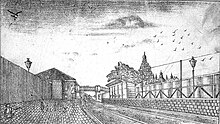Byculla railway station
This article relies largely or entirely on a single source. (February 2019) |
Byculla (station code: BY) is railway station on the Central line of the Mumbai Suburban Railway. It is located in the neighbourhood of Byculla.
The station is a Grade-I heritage structure. The other 4 railway stations on Mumbai's heritage list include Chhatrapati Shivaji Maharaj Terminus, Western Railways Headquarters Building (Churchgate), Bandra railway station and Reay Road railway station.[1]
History
[edit]Byculla was one of the original stations when the Bombay–Thane railway was inaugurated in April 1853. It had been built as a wooden structure the year before, but was rebuilt in 1857 as a stone structure. It took on its current form in June 1891.
The first locomotive was brought to Mumbai in 1852 through street of Byculla and around 200 laborers pulled it. This Locomotive, named Lord Falkland (after Bombay's then governor) was stationed on a grove near Byculla bought by the GIPR from a landlord, William Phipps at a cost of ₹4000. The engine was used for shunting operations, and had its first run on 18th February, 1852, from Byculla to Parel.[2]
The Old Station
The original Byculla station was located about 500 m south of the current station, beside where the Byculla Mankeshwar is located today. In fact the temple was mentioned by Lady Falkland, (the wife of Bombay's then governor) in her memoir of a rail journey along the line, who stated that the temple "was on verge of completion, when the line was opened."[3] The temple, which was located on the east of the former station, is also a prominent element of the station's oldest photos. Also a notable part of the old photos is a bridge on the Parell Rd, on the northern side of the station.

A picture of the station from its western platform (reproduced below) was published in the book 'Lokhandi Rastyanchey Sanchipt Varnan', A translation by Krishnashastri Bhatwadekar. The photograph shows the Mankeshwar temple on the right side. The station itself was fenced on either sides. Some buildings can also be seen on the station: one on the western side, and another on the eastern; with the former more elaborately roofed. The bridge can be seen afar, also elaborately designed, with onlookers overlooking the line from above.

The published photograph further ascertains the location of the station mentioned above. It matches both the curve of the line at the site today, and the location of the temple at the east.[4]
The station was still a small one. It only had two lines catering it, and didn't have many buildings along with a narrow entrance. Indeed there is an anecdote about Dr. W.C. Eccles, a surgeon of the GIP Railway regarding this element of the station. The incident goes that in 1867, while on an official visit, a shaft of his brougham broke while passing through the then Byculla station's narrow entrance. Determined to get the repairs done, free of the cost, he wrote a letter to the company's agent (General manager) on 6th March 1867, regarding the same. The agent's secretary wrote that this couldn't be sanctioned. This could be a reason, why today's Byculla station has a wide porch.
Nevertheless, the station was fashionable among the upper class British passengers boarded from this station, as it was more elaborate than the terminus, Bori Bunder station.[5]
The Original Workshop
Byculla was also the location, where the first workshops of GIPR were opened in 1854. The workshops were spread over 18 acres of land, with steam sheds, erecting and fitting shops, metal foundries, sawmills, carriage repairing quarters and wagon building sheds, warehouses, timber preservation cabins, offices, and dwelling spaces. The workshops were later shifted to a larger plot at Parel in the 1870s, owing to increased traffic.[6]
Later changes
The station was later Rebuilt in 1857, and then again in 1891. The station was shifted north of its old location, and a larger building was built on the site the present station stands. The new station consisted of the station building, platforms, sheds, footbridges, horse carriage parkings, and staff quarters, all of which were complete by June 1891.

Etymology
[edit]The name Byculla appears to have derived from word Bhay (Marathi:भाय = Bawa) & khala (Marathi:खळा = area to store grains), Meaning Priest's Grain storage.
Gallery
[edit]-
Byculla railway station platform
-
Byculla Station Banner
-
Information on Restoration of Byculla station
References
[edit]- ^ "Mumbai Metropolitan Region – Heritage Conservation Society's Regulation Guidelines" (PDF). MMR-HCS. Retrieved 27 June 2022.
- ^ Aklekar, Rajendra B. (16 April 2016). "Bombay Railway & History Group: 16 points about India's first train journey -- 163 years of Indian Railways". Bombay Railway & History Group. Retrieved 14 May 2023.
- ^ "Instagram".
- ^ "१२१. लोखंडी रस्त्याचे संक्षिप्त वर्णन - कृष्णाशास्त्री भाटवडेकर.PDF".
- ^ "The Tribune - Windows - Main Feature--Breathing new life into samadhis by Roopinder Singh".
- ^ Aklekar, Rajendra B. (2014). Halt Station India : The Dramatic Tale of the Nation's First Rail Lines. Rupa Publications. p. 83. ISBN 978-81-291-3497-4.
External links
[edit]- An Old Marathi Book on Railways from 1854, with Photographs of Bori Bunder Station and Byculla Station See pg 37, 49 respectively.






